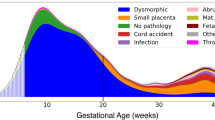Abstract
Objectives
To investigate the effect of maternal obesity on pregnancy outcome and placental histopathology.
Study Design
Pregnancy outcome and placental histology from term pregnancies were reviewed. Women were divided according to their prepregnancy body mass index (BMI, kg/m2) as normal weight (18-24.9) and obese (≥30). Pregnancy outcome and placental histology were compared between obese and normal weight women with complicated pregnancies, and with uncomplicated pregnancies, matched by mode of delivery. Placental lesions were classified as lesions of maternal or fetal vascular supply and maternal (MIR) and fetal (FIR) inflammatory responses.
Results
Of the 1047 complicated pregnancies analyzed, 615 were with normal weight (BMI 21.7 ± 1.8) and 221 were obese (BMI 35.2 ± 4.3). Obesity was associated with higher rates of diabetes and hypertensive disorders (P = .001 for both), birth weight >90th, P < .001, and cesarean delivery, P < .001. Placental weight was higher in obese than in normal weight women, P < .001. No difference was observed in the rate of placental lesions related to maternal or fetal vascular supply and MIR or FIR between the groups. However, higher rate of maternal placental vascular lesions (46.8% vs 28.2%, P = .012) was observed in uncomplicated obese women (n = 62) as compared with healthy normal weight (n = 124) uncomplicated controls.
Conclusion
Pregnancy outcome is worse without different placental component in obese versus normal weight women, with complicated pregnancies. In uncomplicated pregnancies, more maternal placental vascular supply lesions exist in obese versus normal weight women, suggesting background placental compromise.
Similar content being viewed by others
References
Cnattingius S, Bergstrom R, Lipworth L, Kramer MS. Prepregnancy weight and the risk of adverse pregnancy outcomes. N Engl J Med. 1998;338(3):147–152.
Crane SS, Wojtowycz MA, Dye TD, Aubry RH, Artal R. Association between pre-pregnancy obesity and the risk of cesarean delivery. Obstet Gynecol. 1997;89(2):213–216.
Edwards LE, Hellerstedt WL, Alton IR, Story M, Himes JH. Pregnancy complications and birth outcomes in obese and normal-weight women: effects of gestational weight change. Obstet Gynecol. 1996;87(3):389–394.
Galtier-Dereure F, Montpeyroux F, Boulot P, Bringer J, Jaffiol C. Weight excess before pregnancy: complications and cost. Int J Obes Relat Metab Disord. 1995;19(7):443–448.
Thadhani R, Stampfer MJ, Hunter DJ, Manson JE, Solomon CG, Curhan GC. High body mass index and hypercholesterolemia: risk of hypertensive disorders of pregnancy. Obstet Gynecol. 1999;94(4):543–550.
Boney CM, Verma A, Tucker R, Vohr BR. Metabolic syndrome in childhood: association with birth weight, maternal obesity, and gestational diabetes mellitus. Pediatrics. 2005;115(3):e290–e296.
Yaniv-Salem S, Shoham-Vardi I, Kessous R, Pariente G, Sergienko R, Sheiner E. Obesity in pregnancy: what’s next? Long-term cardiovascular morbidity in a follow-up period of more than a decade [published online March 3, 2015]. J Matern Fetal Neonatal Med. 2015:1–5.
Jeve YB, Konje JC, Doshani A. Placental dysfunction in obese women and antenatal surveillance strategies. Best Pract Res Clin Obstet Gynaecol. 2015;29(3):350–364.
Bar J, Schreiber L, Saruhanov E, Ben-Haroush A, Golan A, Kovo M. Placental histopathological findings in obese and nonobese women with complicated and uncomplicated pregnancies. Arch Gynecol Obstet. 2012;286(6):1343–1347.
Huang L, Liu J, Feng L, Chen Y, Zhang J, Wang W. Maternal pre-pregnancy obesity is associated with higher risk of placental pathological lesions. Placenta. 2014;35(8):563–569.
Dollberg S, Haklai Z, Mimouni FB, Gorfein I, Gordon ES. Birth weight standards in the live-born population in Israel. Isr Med Assoc J. 2005;7(5):311–314.
World Health Organization.Obesity: preventing and managing the global epidemic. Report of a WHO consultation. World Health Organization technical report series 894. 2000:i–xii, 1–253.
Redline RW, Heller D, Keating S, Kingdom J. Placental diagnostic criteria and clinical correlation–a workshop report. Placenta. 2005;26(suppl A):S114–S117.
Redline RW. Placental pathology: a systematic approach with clinical correlations. Placenta. 2008;29(suppl A):S86–S91.
Kovo M, Schreiber L, Ben-Haroush A, et al. The placental factor in early- and late-onset normotensive fetal growth restriction. Placenta. 2013;34(4):320–324.
Bar J, Schreiber L, Golan A, Kovo M. Placental factor in spontaneous term labor in uncomplicated pregnancy. J Matern Fetal Neonatal Med. 2012;25(12):2704–2707.
Rich-Edwards JW, Goldman MB, Willett WC, et al. Adolescent body mass index and infertility caused by ovulatory disorder. Am J Obstet Gynecol. 1994;171(1):171–177.
Sebire NJ, Jolly M, Harris JP, et al. Maternal obesity and pregnancy outcome: a study of 287,213 pregnancies in London. Int J Obes Relat Metab Disord. 2001;25(8):1175–1182.
Pathak S, Lees CC, Hackett G, Jessop F, Sebire NJ. Frequency and clinical significance of placental histological lesions in an unselected population at or near term. Virchows Arch. 2011; 459(6):565–572.
Robinson BK, Su E, Grobman W, Huang M, Ernst LM. The association of histologic placental inflammation with category II fetal heart tracings. Pediatr Dev Pathol. 2012;15(4):298–302.
Challier JC, Basu S, Bintein T, et al. Obesity in pregnancy stimulates macrophage accumulation and inflammation in the placenta. Placenta. 2008;29(3):274–281.
Hastie R, Lappas M. The effect of pre-existing maternal obesity and diabetes on placental mitochondrial content and electron transport chain activity. Placenta. 2014;35(9):673–683.
Higgins L, Mills TA, Greenwood SL, Cowley EJ, Sibley CP, Jones RL. Maternal obesity and its effect on placental cell turnover. J Matern Fetal Neonat Med. 2013;26(8):783–788.
Stanek J. Comparison of placental pathology in preterm, latepreterm, near-term, and term births. Am J Obstet Gynecol. 2014; 210(3):234. e1–e6.
Hayward CE, Higgins L, Cowley EJ, et al. Chorionic plate arterial function is altered in maternal obesity. Placenta. 2013;34(3): 281–287.
Lim R, Lappas M. Slit2 exerts anti-inflammatory actions in human placenta and is decreased with maternal obesity. Am J Reprod Immunol. 2015;73(1):66–78.
Author information
Authors and Affiliations
Corresponding author
Rights and permissions
About this article
Cite this article
Kovo, M., Zion-Saukhanov, E., Schreiber, L. et al. The Effect of Maternal Obesity on Pregnancy Outcome in Correlation With Placental Pathology. Reprod. Sci. 22, 1643–1648 (2015). https://doi.org/10.1177/1933719115592712
Published:
Issue Date:
DOI: https://doi.org/10.1177/1933719115592712




